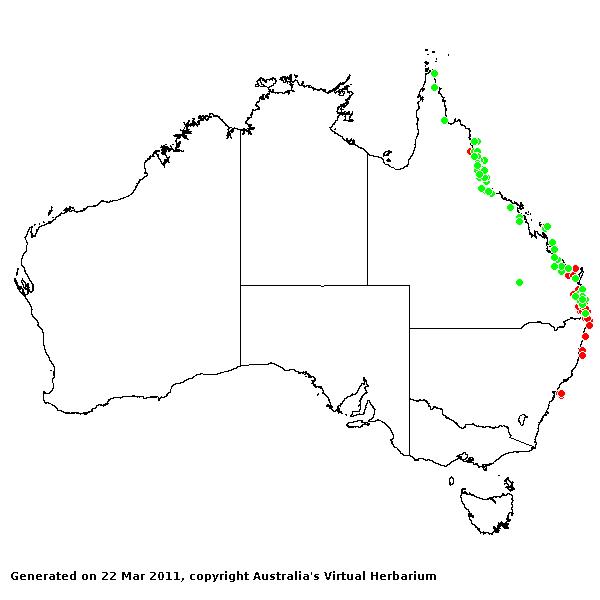Ottochloa J. Bot. 69: 54 (1931).
Derivation:. Named for Otto Stapf 1857–1933, Austrian born botanist at Kew.
Taxonomic revisions, nomenclatural references:. M.Lazarides, Austr. J. Bot. 5: 1–51 (1961).
Key references (keys and floras):. E.E.Henty, Manual Grasses New Guinea 137 (1969); J.W.Vickery, Flora of New South Wales, Gramineae 19: 137–138 (1975); M.Lazarides, Tropical Grasses S.E. Asia 125–126 (1980); J.C.Tothill and J.B.Hacker, Grasses of Southern Queensland 318–319 (1983); R.D.Webster, Australian Paniceae 116–118 (1987); B.K.Simon, Key to Australian Grasses 134 (1993); S.W.L.Jacobs and C.A.Wall, Flora of New South Wales 4: 477 (1993); S.W.L.Jacobs, R.D.B.Whalley & D.J.B.Wheeler, Grasses of New South Wales, 4th ed, 310–311 (2008).
W.D.Clayton & S.A.Renvoize, Genera Graminum (1986), genus (468).
Native. 5 species, from Africa, Indomalayan region, Australia. 2 species in Australia, Qld and NSW. Also New Guinea and Malesia.
Habit. Perennial, decumbent (slender). Leaf blades broad or narrow. Ligule an unfringed membrane to a fringed membrane.
Inflorescence. Inflorescence paniculate (the branches weakly unilateral, with appressed secondary racemelets), an open panicle with branches ending in single spikelets, open, non-digitate.
Spikelets. Spikelets dorsally compressed, 2 flowered, with 1 fertile floret, solitary or paired, pedicelled (the pedicels widened upwards). Fertile spikelets with lower incomplete floret(s), elliptic, abaxial or not orientated, falling with glumes.
Glumes. Glumes more or less equal, shorter than spikelet (about 1/2 to 2/3 as long), shorter than adjacent lemmas, hairless (usually glabrous), pointed, awnless, similar (membranous). Lower glume 3 nerved. Upper glume 3–5 nerved.
Florets. Lower incomplete floret(s) male. Lemmas awnless, 5–9 nerved, more or less equalling fertile lemmas, less firm than fertile lemmas, not becoming indurated. Fertile florets 1. Lemmas decidedly firmer than glumes (subleathery), smooth to striate, becoming indurated to not becoming indurated, yellow in fruit, entire at apex, pointed, muticous to mucronate (or rather, apiculate to mucronulate), with a clear germination flap, 3–5 nerved, glabrous. Palea relatively long, entire, textured like lemma, 2 nerved. Lodicules 2. Stamens 3. Grain small, compressed dorsiventrally (strongly). Hilum short. Embryo large.
Kranz Anatomy. C3.
2n = 18, 2 ploid.
Habitat. Damp and shady places. Shade species and species of open habitats.
Classification. Panicoideae; Paniceae.
Notes. A tropical genus with 2 species in Australia, one in Africa and 3 in Asia. Diagnostic features include the relatively short upper glume and mucronate apex of the upper lemma. Additional important characters include the decumbent habit and muricate upper floret (Webster 1987).
Types Species. O. nodosa (Kunth) Dandy.
Biogeographic Element. Clifford & Simon 1981, Simon & Jacobs 1990: Old World Tropics.


